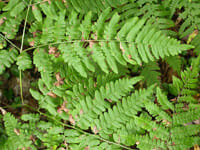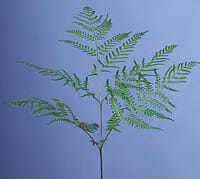Bracken Fern – Polypodiales Polypodiaceae Pteridium aquilinum
 |
 |
 |
 |
 |
Identification & Description:
Bracken is a large fern, sometimes growing over three feet tall. Instead of the usual leaves, ferns have fronds, made up of smaller leaflets (groups of mini-leaves) with small pinnae (tiny mini-leaves) on them.
Bracken fronds are shaped like triangles. Each frond usually has three leaflets.
Bracken grow in large colonies in fields, brushy areas, and woods. They have thick root-like stems, called rhizomes, underground. Rhizomes can grow six feet long, and many fronds may grow from one rhizome. Each rhizome also has tiny, hair-like, black roots on it.
Physical Characteristics
Fern growing to 1.2m by 2m at a fast rate. It is hardy to zone 4. The seeds ripen from July to August. We rate it 2 out of 5 for usefulness.
The plant prefers light (sandy), medium (loamy) and heavy (clay) soils. The plant prefers acid and neutral soils and can grow in very acid soil. It can grow in semi-shade (light woodland) or no shade. It requires dry or moist soil. The plant can tolerate maritime exposure.
Edible Uses
Leaves; Root; Sweetener.
Root – cooked. It can be dried and ground into a powder. The root is very fibrous so traditionally it was baked after being dried, the outer skin was peeled off and the roots pounded into a powder with sticks so that the inner fibres could be removed. The dried root will store for years. The root contains 60% starch. The dry weight content of starch is between 43 and 72%. This starch can be extracted from the roots and is used in making dumplings which are eaten with soya flour and sugar as a delicacy. The root has a somewhat constipating effect upon the body so is best eaten with foods that have a laxative quality.
Young shoots, harvested when still unfurling, can be eaten raw or cooked. They can be used like asparagus or like spinach. Somewhat flavourless, though they are considered to be a delicacy in Japan. The fronds should be used when less than 20cm long, longer ones have a terrible taste. The shoots are somewhat bitter so they are often blanched for a few minutes in boiling water, then left to soak in cold water for two hours before being cooked. Although this might well improve the flavour, it will greatly reduce the nutritional value. The shoots should be steeped in lye first. Occasional use should cause no problems, but regular consumption is not advisable because the shoots might be carcinogenic.
The plant yields an edible saccharine substance. (from the cooking root??).
Other Uses
Adhesive; Basketry; Biomass; Compost; Dye; Hair; Lining; Mulch; Packing; Repellent; Soap; Soap making; Stuffing; Thatching; Tinder.
A glue can be made from the rootstock.
A brown dye is obtained from the fronds. It is green according to another report.
The fibrous remnants from edible roots make a good tinder.
The rhizome lathers readily in water and can be used as a soap. A decoction of the root has been used as a hair wash.
The roots have been rubbed into the scalp in order to promote hair growth.
The roots have been pounded to remove the bark, then split into flat bands and used as the black strands of cheap baskets.
The ashes of the plant are rich in potassium and could be used as a fertilizer. They are also used in the manufacture of glass (when mixed with sand) and in making soap (when mixed with vegetable oil). The roots contain up to 20% potash in early summer, but this reduces to about 5% in the autumn.
The whole plant is a very valuable addition to the compost heap, it is rich in potash and makes an excellent compost for tree seeds. Cut twice a year if you want the plants to continue growing, three cuts annually will weaken and eventually kill off the plants.
The dried ferns produce a very durable thatch.
The leaves are used as a packing material for fruit, keeping it fresh and cool without imparting any colour or flavour. They are also used as a lining for baskets, fruit drying racks etc and as a bedding. The leaves repel insects and can help to prevent rot in the fruits etc.
Dried bracken fronds are very useful in the garden as a mulch for somewhat tender plants. This will keep the soil warmer, protect from wind damage and also keep off some of the rain.
Range
Southern bracken is found in most of the eastern United States between Florida and Oklahoma in the south, to Missouri, Illinois, and Massachusetts in the north. Eastern bracken is found between Oklahoma and North Carolina in the south, to Minnesota, Quebec, and Newfoundland in the north.
Cultivation details
Prefers a light, acid, deep sandy soil. Dislikes shade according to some reports whilst another says that it tolerates full sun but prefers light shade. Prefers a pH in the range 4 to 6.
Members of this genus are rarely if ever troubled by browsing deer.
This is an extremely invasive plant and is a noxious weed. It is one of the most widespread plants in the world, being found in all parts of the globe other than the extreme north and south. Plants can be cut down twice a year to provide compost material, this will not kill the plants. If the plants are cut down three times a year this will gradually weaken and eventually kill them.
Bracken Fern – Polypodiales Polypodiaceae Pteridium aquilinum
 |
 |
 |
 |
 |
Identification & Description:
Bracken is a large fern, sometimes growing over three feet tall. Instead of the usual leaves, ferns have fronds, made up of smaller leaflets (groups of mini-leaves) with small pinnae (tiny mini-leaves) on them.
Bracken fronds are shaped like triangles. Each frond usually has three leaflets.
Bracken grow in large colonies in fields, brushy areas, and woods. They have thick root-like stems, called rhizomes, underground. Rhizomes can grow six feet long, and many fronds may grow from one rhizome. Each rhizome also has tiny, hair-like, black roots on it.
Physical Characteristics
Fern growing to 1.2m by 2m at a fast rate. It is hardy to zone 4. The seeds ripen from July to August. We rate it 2 out of 5 for usefulness.
The plant prefers light (sandy), medium (loamy) and heavy (clay) soils. The plant prefers acid and neutral soils and can grow in very acid soil. It can grow in semi-shade (light woodland) or no shade. It requires dry or moist soil. The plant can tolerate maritime exposure.
Edible Uses
Leaves; Root; Sweetener.
Root – cooked. It can be dried and ground into a powder. The root is very fibrous so traditionally it was baked after being dried, the outer skin was peeled off and the roots pounded into a powder with sticks so that the inner fibres could be removed. The dried root will store for years. The root contains 60% starch. The dry weight content of starch is between 43 and 72%. This starch can be extracted from the roots and is used in making dumplings which are eaten with soya flour and sugar as a delicacy. The root has a somewhat constipating effect upon the body so is best eaten with foods that have a laxative quality.
Young shoots, harvested when still unfurling, can be eaten raw or cooked. They can be used like asparagus or like spinach. Somewhat flavourless, though they are considered to be a delicacy in Japan. The fronds should be used when less than 20cm long, longer ones have a terrible taste. The shoots are somewhat bitter so they are often blanched for a few minutes in boiling water, then left to soak in cold water for two hours before being cooked. Although this might well improve the flavour, it will greatly reduce the nutritional value. The shoots should be steeped in lye first. Occasional use should cause no problems, but regular consumption is not advisable because the shoots might be carcinogenic.
The plant yields an edible saccharine substance. (from the cooking root??).
Other Uses
Adhesive; Basketry; Biomass; Compost; Dye; Hair; Lining; Mulch; Packing; Repellent; Soap; Soap making; Stuffing; Thatching; Tinder.
A glue can be made from the rootstock.
A brown dye is obtained from the fronds. It is green according to another report.
The fibrous remnants from edible roots make a good tinder.
The rhizome lathers readily in water and can be used as a soap. A decoction of the root has been used as a hair wash.
The roots have been rubbed into the scalp in order to promote hair growth.
The roots have been pounded to remove the bark, then split into flat bands and used as the black strands of cheap baskets.
The ashes of the plant are rich in potassium and could be used as a fertilizer. They are also used in the manufacture of glass (when mixed with sand) and in making soap (when mixed with vegetable oil). The roots contain up to 20% potash in early summer, but this reduces to about 5% in the autumn.
The whole plant is a very valuable addition to the compost heap, it is rich in potash and makes an excellent compost for tree seeds. Cut twice a year if you want the plants to continue growing, three cuts annually will weaken and eventually kill off the plants.
The dried ferns produce a very durable thatch.
The leaves are used as a packing material for fruit, keeping it fresh and cool without imparting any colour or flavour. They are also used as a lining for baskets, fruit drying racks etc and as a bedding. The leaves repel insects and can help to prevent rot in the fruits etc.
Dried bracken fronds are very useful in the garden as a mulch for somewhat tender plants. This will keep the soil warmer, protect from wind damage and also keep off some of the rain.
Range
Southern bracken is found in most of the eastern United States between Florida and Oklahoma in the south, to Missouri, Illinois, and Massachusetts in the north. Eastern bracken is found between Oklahoma and North Carolina in the south, to Minnesota, Quebec, and Newfoundland in the north.
Cultivation details
Prefers a light, acid, deep sandy soil. Dislikes shade according to some reports whilst another says that it tolerates full sun but prefers light shade. Prefers a pH in the range 4 to 6.
Members of this genus are rarely if ever troubled by browsing deer.